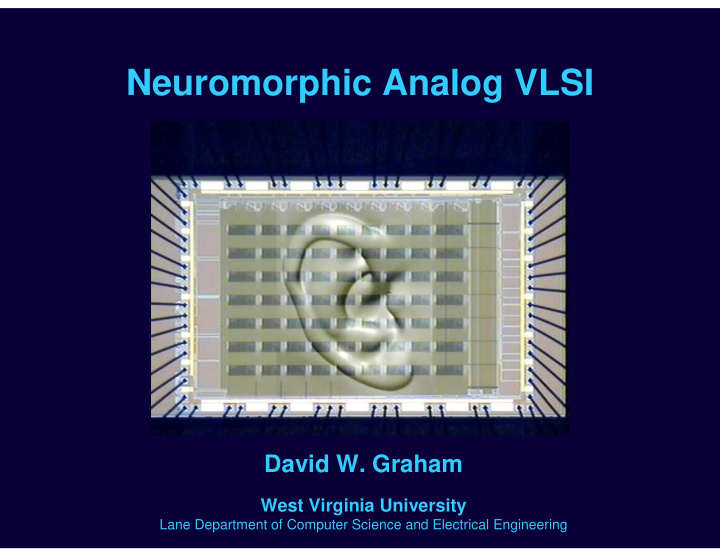



Neuromorphic Analog VLSI David W. Graham West Virginia University Lane Department of Computer Science and Electrical Engineering 1
������������ ����������� ��������������������� � ������������ � ������ � ���� 2
�������������������&�����' ���������� ����� �"#������� ���������� �$%��������������������� ��������������������� ��$��� !���������� ������ !������ 3
������������!&��()������������������ ������������!&��()������������������ * +�����������'������������������������������ � ,���(-�����'����������� � ��������������������� ������������ �'����� ��������������������� ��������������������� ���������6���'����� ������� ��������.����� ��'���������������� �/)0��������� ��'���������������� �������������������� ��������������1� �.��������������� �+�������������������' ��������������� �������'����� �3���22����4 ����� �������2��������� �/��������������� ��������������������'����� �5�������22���������� �,����������� �&������������������� �/���������������� 4
�'������������� �����������7 Interest in exploring Interest in building neuroscience neurally inspired systems Key Advantages • The dynamics is the system • What if our primitive gates were a neuron computation? a synapse computation? a piece of dendritic cable? • Efficient implementations compute in their memory elements – more efficient than directly reading all the coefficients • Precise systems out of imprecise parts 5
&�����'�������������5�6���� Similar physics of biological channels and p-n junctions • Drift and Diffusion equations form a built-in Barrier (V bi versus Nernst Potential) • Exponential distribution of particles (Ions in biology and electrons/holes in silicon) Both biological channels and transistors have a gating mechanism that modulates a channel. 6
/�����������2������� Molecules Channels Synapses Neurons CNS 1 µ m 0.1nm 10nm 0.1mm 1cm 1m Silicon PIII Parallel Logic Multipliers Transistors Processors Gates 7
������������ 8������� ������������ ����������������� ������6��'�'�����2����9��,���6��:���� ���������'����������������6��'� ����������������9�� ����������;���1���� �&9�909(&��������.��������� ������������ �������������������� �������������6���������2������2� ������������9�� 8
�����/��� ��<�7�� &��(����������'����� �������������� ���(8����������� ������� �/������������������� �������������5�6���� �,����������� ������������� 5����� �/���������������� �������8�������������' 8����2���)�=��(��������'����� 8��6�������������2�������� �������������������� �8�������������' ��������' �.����2����������' �3������������������4 �����������6������������������2������������ 9
�'�������7�� � )���������������������������� � /������2�������'��������������2������ ����������22�������'������������� � >������������������'�������������� ������������'����� 10
�������8�������6���� Gene's Law Gene's Law 100W DSP Power DSP Power CADSP Power CADSP Power Power Dissipated / MMAC <���?����� 1W � 8������������������2��������������������� �����������=����������'��6������� 10mW � >�������)����?����� Programmable Analog Power � �������������������'����������������� 0.1mW Savings ��������6������-����������$��'������������ >20 Year Leap 1 µ µ W ���������' µ µ in Technology 10nW 1980 1990 2000 2010 2020 2030 Year >>;�6�9��������/��������)���� � @$��������� ���AA9�1,B � >>;�����������#� �C�����(������������5�8D � ����������������E#F � ���������������6������2������ 11
�'�����7���� • Cheaper (and easier to mass produce) • Smaller • Reduces power • Keeps everything contained – Reduces noise – Reduces coupling from the environment • Need a large number of transistors to perform real-world computations/tasks • Allows a high density or circuit elements (therefore, VLSI reduces costs) 12
5�22�������&�������5�����������������5����� Analog VLSI Discrete Analog Relatively Small Large Device Size and ex. Capacitors 100pF-100 � F Values ex. Capacitors 10fF-10pF Mostly bad Easy to Use Resistors Very expensive (large real estate) Cheap Only feasible for very high frequencies Use when needed Inductors Extremely expensive Very big concern Exist, but rarely affect performance Parasitics Seriously alter system performance (Large size of devices and currents) Difficult to deal with Concern Major concern Can more easily match/replace Matching Stuck with whatever was fabricated ex. 50% mismatch is not uncommon Efficient Use more power Power (Small currents pA-mA) (Large currents >mA) 13
;���������B��G Good Things about Analog VLSI • Inexpensive • Compact • Power Efficient Not So Good Things about Analog VLSI (not necessarily bad) • Limited to transistors and capacitors (and sometimes resistors if a very good reason) • Parasitics and device mismatch are big concerns • You are stuck with what you built/fabricated (no swapping parts out) However, Neuromorphic Analog VLSI is all about how to cope with these “problems,” how to get around them, and how to use them as an advantage 14
����������/������������� We will limit our discussion to CMOS technologies • No BJTs • Only MOSFETs Therefore, we will discuss only silicon processes 15
�6��'�����'����������������G Looking at connections with neurobiology • Begin at MOS device physics • Look at circuits using the device properties • Building small systems from circuits 16
Recommend
More recommend